![]()
![]()
![]()
Use LEFT and RIGHT arrow keys to navigate between flashcards;
Use UP and DOWN arrow keys to flip the card;
H to show hint;
A reads text to speech;
92 Cards in this Set
- Front
- Back
|
4 ascocarp types |
Cleistothecium, apothecium, perithecium, locule |
|
|
Cleistothecium |
Closed sheath, spherical, round asci |
|
|
Apothecium |
Open sheath, hymenium, no timed release, eggs in one basket |
|
|
Perithicium |
Stroma, surround sheath, timed release |
|
|
Locule |
Stroma part of fruiting body |
|
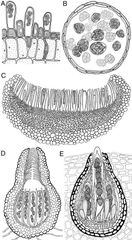
|
A: yeast, B: Cleistothecium, C: Apothecium, D: Perithecium, E: Locule |
|
|
Ascomycota septae |
Simple porate |
|
|
Telemorph |
Sexual state, undergoes meiosis |
|
|
Anamorph |
Asexual state, undergoes mitosis |
|
|
Ascocarp |
Fruiting body |
|
|
Biproduct of yeast |
Ethanol, CO2, water |
|
|
Hypertrophy |
Enlargement of cells |
|
|
Hyperplasia |
Excessive cell reproduction |
|
|
Purpose of hypertrophy and hyperplasia |
Increase surface area for asci growth |
|
|
Plectomycetes and orders |
Ascomycota with cleistothecium Eurotiales Onygenales Erysiphales |
|
|
Moniliaceae vs dermatiaceae |
Light spores vs dark |
|
|
Ascus |
Internal sac of ascomycota where sexual spores are born |
|
|
Conidia |
External structure where asexual spores are born |
|
|
Sex state of Ascomycota |
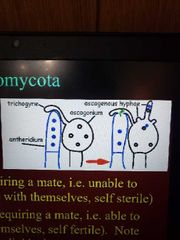
Antheridium moves up into trichogyne and then plasmogamy occurs |
|
|
Heterothallic |
Requires a mate |
|
|
Homothallic |
Able to reproduce with themselves |
|
|
3 new classification subphylums |
Taphrinomycotina: plant pathogens Saccharomycotina: Yeasts Pezizomycotina: everything else |
|
|
Hemiascomycetes |
Half-asscocarp, no fruiting structure |
|
|
Three orders of Hemiascomycetes |
Saccharomycetales: ascus arises from fusion cell Taphrinales: ascus arises from a different cell Protomycetales: more primitive |
|
|
Asexual reproduction (yeasts) |
Budding, disarticulation |
|
|
Saccharomycetales |
Order of hemiascomycetes, Yeasts |
|
|
Taphrinales |
Parasites of vascular plants |
|
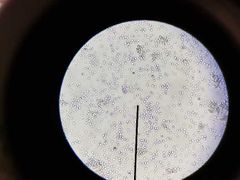
|
Yeast |
|
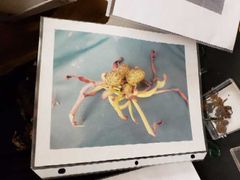
|
Taphrinales |
|

|
Taphrinales life cycle |
|
|
Protomycetales |
Most primitive hemiascomycetes, many modes of reproduction, typically fission, some are pathogens |
|
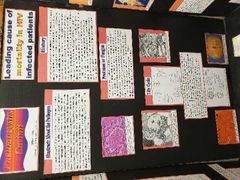
|
Protomycetales |
|
|
Plectomycetes orders |
Eurotiales: cleistothecium, globose asci Onygenales: gymnothecium, loosely woven wall Erysiphales: powdery mildew, broadly clavate asci in a hymenium |
|
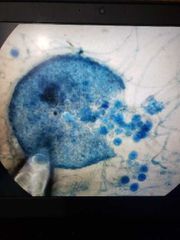
|
Eurotiales |
|
|
Penicillium |
In order eurotiales, antibiotic, cheese |
|
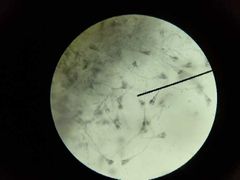
|
Penicillium conidia |
|
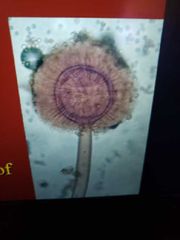
|
Aspergillus |
|
|
Aspergillus |
In order Eurotiales, aflatoxin, citric acid, drugs |
|
|
Onygenales |
Can degrade keratin, medically important, true human pathogens |
|
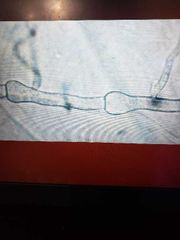
|
Racquet hyphae in onygenales |
|
|
Ringworm and athletes foot |
Onygenales |
|
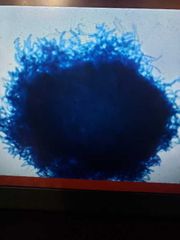
|
Gymnothecium |
|
|
Thermal dimorphs |
Change structure based on temperature |
|
|
Erysiphales |
Powdery mildews, hymenium, obligate parasite, haustoria |
|
|
Haustoria |
Branching structure into host plant cell |
|
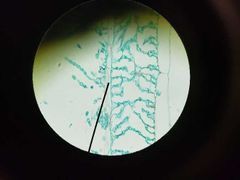
|
Haustoria |
|

|
Cleistothecium of erysiphales |
|
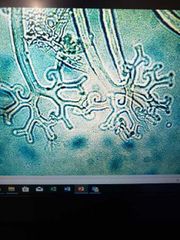
|
Cleistothecial appendages of powdery mildew |
|
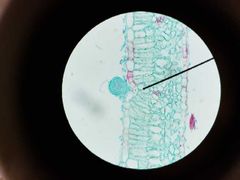
|
Perithecia of erysiphales |
|
|
Aspergillus niger |
Citric acid |
|
|
Perithecium |
Flask structure with apical pore and hymenial layer |
|
|
Stroma |
Mass of sterile tissue |
|
|
Periphyses |
Sterile filaments in tip of Perithecium |
|
|
Paraphyses |
Sterile filaments around asci in Perithecium |
|
|
Ascospore dispersal |
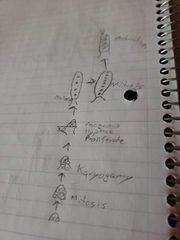
|
|
|
Orders of pyrenomycetes |
Sphaeriales (Xylariales, diaporthales, sordariales) Hypocreales Ophiostomatales |
|
|
Sordariales |
Order in order sphaeriales: single dark Perithecia |
|
|
Xylariales |
Stroma with perithecia embedded |
|
|
Diaporthales |
Long neck/stem |
|
|
Chestnut blight |
Introduced to new york from asia in 1904, caused by Cryphomectria parasitica, canker disease, diaporthales |
|

|
Diaporthales |
|
|
Hypocreales |
Hypocreaceae: brightly colored, soft or waxy, clavixipitaceae: stroma developed, needle like ascospores |
|
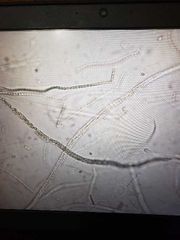
|
Cordyceps |
|
|
Important clavicipitaceae |
Cordyceps, claviceps: ergot poisoning |
|
|
Ophiostomatales |
Beaked perithecia, scattered globose asci |
|
|
Dutch elm disease |
Ophiostomatales |
|
|
Discomycetes |
Apothecium, asci born exposed, ascospores forcibly discharged, |
|
|
Operculate |
Lid like opening in discomycetes |
|
|
Orders of Discomycetes |
Phacidiales: ascospores thread like Helotiales: ascospores rounded Pezizales: operculate asci Tuberales: ascospores spherical and ornamented |
|
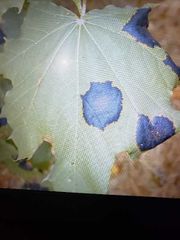
|
Tar spot of maple (Rhytisma acerinum) in phacidiales |
|
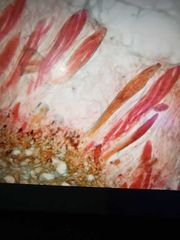
|
Phacidiales |
|
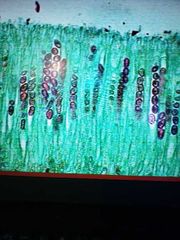
|
Heliotales, Cup or tongue shaped, |
|
|
Pezizales |
Conidia rare, saprophytes, morrells, operculate, |
|
|
Tuberales |
Truffles, all produce ascocarps below ground, spores not discharged, |
|
|
Loculoascomycetes |
Stroma with embedded psuedothecia |
|
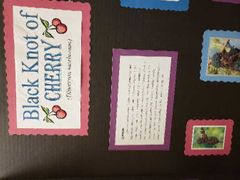
|
Loculoascomycetes |
|
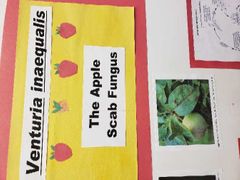
|
Loculoascomycetes |
|
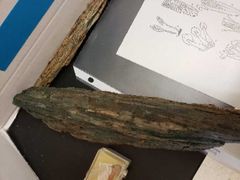
|
Heliotales, blue stain |
|
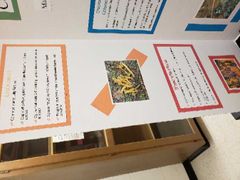
|
Jelly babies, hypocreales |
|

|
Tuberales, truffle |
|
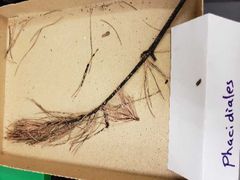
|
Phacidiales |
|
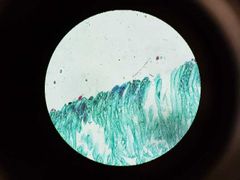
|
Morchella, pezizales |
|
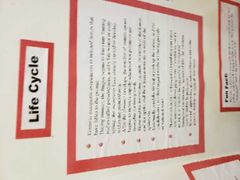
|
Loculoascomycetes |
|
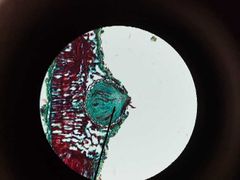
|
Venturia inequalis, apple scab |
|
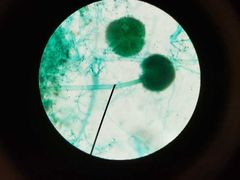
|
Aspergillus |
|
|
Deuteromycetes |
No known teleomorph, alternate classification scheme |
|
|
Three classes of deuteromycetes |
Blastomycetes: Yeasts Coelomycetes: asexual spores borne on pycnidia or acervuli Hyphomycetes: asexual spores borne not on structure |
|
|
Orders of blastomycetes |
Cryptococcales: busding yeast Sporobolomycetes: form on conidia then buller drop |
|
|
Ceolomycetes orders |
Sphaeropsidales: pycnidia Melanconiales: acervuli |
|
|
Hyphomycetes orders |
Hyphomycetales: moniliaceae and dematiaceae Stilbellales: synnata or coremia Tuberculariales: thin pads of sterile hyphae |
|
|
Conidiogenesis forms |
Blastic: comes out top Thallic: extends then splits |
|
|
How does evolution occur with mitosis |
Parasexual cycle, transient diploid, mitotic crossing over, mutation |

